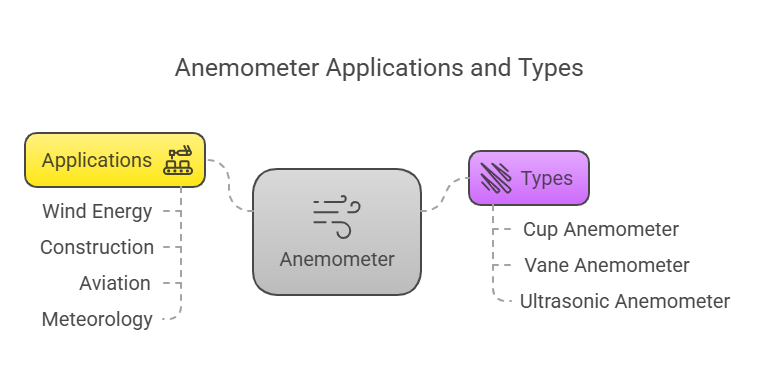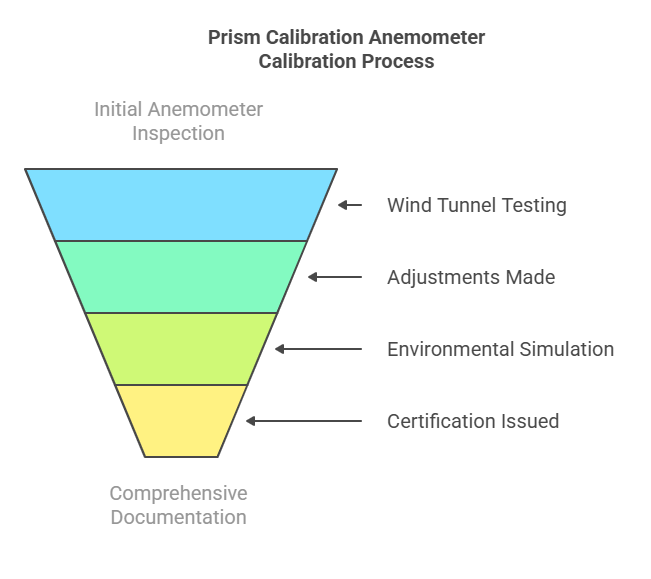Anemometers are critical instruments used to measure wind speed and direction, playing a vital role in ensuring safety and efficiency in high-wind areas such as wind farms, construction sites, and aviation sectors. At Prism Calibration, we specialize in providing precision anemometer calibration services that meet global standards, including ISO/IEC 17025 accreditation and NABL accreditation. Whether you need wind instrument calibration, wind sensor calibration services, or calibration of meteorological instruments, our advanced calibration methods ensure optimal performance, compliance, and safety.
What is an Anemometer?

An anemometer is a device used to measure wind speed and direction. It is widely used in various industries, including:
- Wind Energy: Monitoring wind speed for efficient wind turbine operation.
- Construction: Ensuring safety during high-wind conditions with construction site wind safety measures.
- Aviation: Providing accurate wind measurements for safe takeoffs and landings, adhering to aviation wind measurement standards.
- Meteorology: Collecting data for weather forecasting and environmental monitoring equipment calibration.
Anemometers come in different types, such as cup, vane, and ultrasonic anemometers, each designed for specific applications. Regardless of the type, regular calibration is essential to ensure accurate and reliable measurements.
Anemometer Calibration for Industry Professionals

Our anemometer calibration services are designed for a wide range of professionals who rely on accurate wind measurements:
- Wind Farm Operators: Ensure optimal performance and safety of wind turbines.
- Construction Professionals: Implement construction site wind safety measures to protect workers and equipment.
- Aviation Experts: Maintain compliance with aviation wind measurement standards for safe flight operations.
- Meteorologists: Ensure accurate weather forecasting and environmental monitoring equipment calibration.
- Safety Managers: Mitigate risks associated with high-wind conditions.
By identifying and addressing the specific needs of these professionals, we provide tailored calibration solutions that ensure accuracy, safety, and compliance.
Prism Calibration Anemometer Calibration Process

At Prism Calibration, we follow a meticulous and transparent anemometer calibration process to ensure the highest level of accuracy and reliability. Here’s a step-by-step breakdown of our process:
Initial Inspection
We begin by visually inspecting the anemometer for any physical damage or wear.
Check for proper installation and alignment.
Wind Tunnel Testing
Using state-of-the-art wind tunnel equipment, we test the anemometer across various wind speeds.
Compare the anemometer’s readings against a reference standard to identify discrepancies.
Adjustments
If any inaccuracies are detected, our expert technicians make precise adjustments to restore accuracy.
Ensure the anemometer performs optimally under different wind conditions.
Environmental Simulation
We simulate real-world operating conditions by accounting for factors like temperature and humidity control.
This ensures the anemometer performs accurately in its intended environment.
Certification
Once calibrated, the anemometer is issued a calibration certificate with NIST Traceability.
The certificate includes detailed information about the calibration process and results.
Documentation and Reporting
We provide comprehensive calibration reports, including test data, adjustments made, and compliance with ISO/IEC 17025 standards.
These reports are essential for audits and quality assurance.
Inclusion of Global Standards
At Prism Calibration, we adhere to the highest global standards to ensure your anemometer meets regulatory requirements:
ISO/IEC 17025 Accreditation: Our calibration processes comply with international standards, ensuring accuracy and reliability.
NABL Accreditation: Our services are accredited by the National Accreditation Board for Testing and Calibration Laboratories.
NIST Traceability: Our calibration certificates are traceable to the National Institute of Standards and Technology, providing confidence in the accuracy of your measurements.
Compliance with these standards is essential for maintaining regulatory compliance and ensuring the accuracy and reliability of your wind measurements.
Risks of Improper Calibration
Incorrect or missed calibration of anemometers can lead to significant risks, including:
- Inaccurate Readings: Leading to dangerous decisions in high-wind conditions.
- Safety Hazards: Increased risk of accidents in construction sites, aviation, and wind farms.
- Operational Inefficiencies: Reduced performance of wind turbines and other equipment.
- Non-Compliance: Failure to meet regulatory standards, resulting in penalties and legal issues.
Regular calibration ensures that your anemometer provides accurate and reliable measurements, mitigating these risks and ensuring safety and compliance.
Preventive Maintenance and Long-Term Benefits

Regular calibration plays a crucial role in preventive maintenance and ensuring long-term equipment accuracy. Here’s how:
- Extended Equipment Lifespan: Proper calibration reduces wear and tear, extending the life of your anemometer.
- Cost Savings: Preventing costly errors and downtime caused by inaccurate measurements.
- Improved Accuracy: Ensuring precise wind measurements for better decision-making.
- Regulatory Compliance: Meeting industry standards and avoiding penalties.
By incorporating regular calibration into your maintenance schedule, you can ensure the long-term accuracy and reliability of your anemometer.
Why Hire Professionals for Anemometer Calibration
Hiring professionals for anemometer calibration ensures:
- Expertise and Experience: Our team has the knowledge and skills to handle even the most complex calibration challenges.
- State-of-the-Art Facilities: Our calibration labs are equipped with advanced technology and equipment.
- Compliance with Global Standards: We adhere to ISO/IEC 17025 and NABL accreditation standards.
- Comprehensive Service Offerings: From wind instrument calibration to environmental monitoring equipment calibration, we offer a wide range of services.
- Quick Turnaround Time: We understand the importance of minimizing downtime, so we provide fast and efficient calibration services.
Ensure the accuracy and reliability of your anemometers with Prism Calibration’s expert anemometer calibration services. Contact us today to schedule your calibration or learn more about our wind sensor calibration services. Let us help you achieve precision, safety, and compliance.
Conclusion
Anemometer calibration is essential for ensuring accurate wind measurements, safety, and compliance in high-wind areas. At Prism Calibration, we provide precision anemometer calibration services that meet global standards, ensuring optimal performance and reliability. Contact us today to schedule your calibration or learn more about our wind sensor calibration services.
For expert calibration solutions, Contact us today at Prism Calibration and keep your instruments performing accurately!
FAQs about anemometer calibration
Anemometer calibration is the process of adjusting and testing wind measurement devices to ensure they provide accurate wind speed and direction readings.
The frequency depends on usage and industry standards, but we recommend annual calibration for most applications.
Yes, all calibrated anemometers come with a NIST Traceable calibration certificate.
Absolutely! We specialize in calibrating cup, vane, and ultrasonic anemometers.
We adhere to ISO/IEC 17025 and NABL accreditation standards.
The turnaround time depends on the complexity of the calibration, but we strive to complete most calibrations within 2-3 business days.
Author Bio
Mr. Parthiv Kinariwala is a leading expert in calibration and testing services, with over 20 years of experience in the industry. As the founder of Prism Calibration, established in 2004, Mr. Kinariwala has been at the forefront of delivering precise and reliable calibration, testing, and validation solutions across various industries. His expertise in providing services that meet international calibration standards has earned the trust of major clients, including Reliance Industries, Zydus Cadila, Indian Oil, ONGC, Adani, and Tata.
With a deep understanding of instrumentation, measurement accuracy, and industrial testing, Mr. Kinariwala ensures that each client receives exceptional service tailored to their specific needs. His unwavering commitment to quality and precision has established Prism Calibration as a trusted partner for some of the largest and most respected organizations in the industry.







